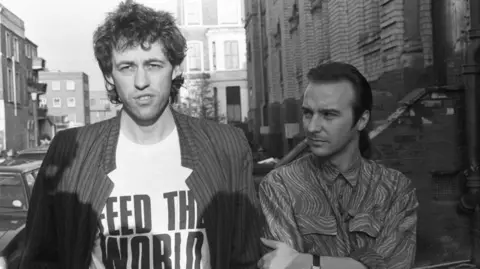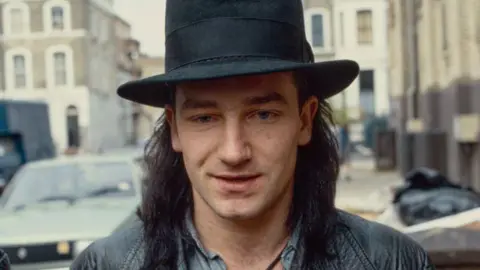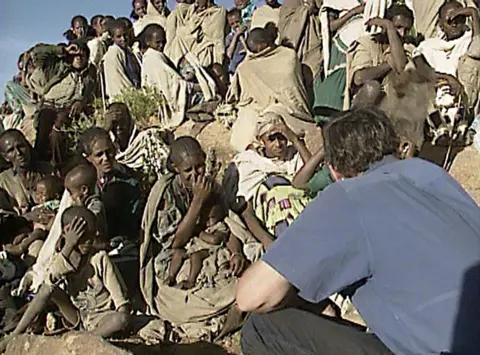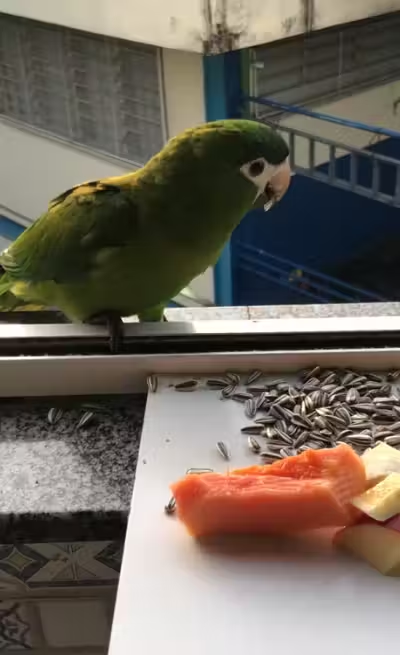MUNDO
‘We knew Christmas before your ancestors’
PUBLICADO
7 meses atrásem
 AFP
AFPForty years on from the original recording, the cream of British and Irish pop music past and present are once again asking whether Ethiopians know it is Christmas.
In 1984, responding to horrific images of the famine in northern Ethiopia broadcast on the BBC, musicians Bob Geldof and Midge Ure corralled some of the biggest stars of the era to record a charity song.
The release of the Band Aid single, and the Live Aid concert that followed eight months later, became seminal moments in celebrity fundraising and set a template that many others followed.
Do They Know It’s Christmas? is back on Monday with a fresh mix of the four versions of the song that have been issued over the years.
But the chorus of disapproval about the track, its stereotypical representation of an entire continent – describing it as a place “where nothing ever grows; no rain nor rivers flow” – and the way that recipients of the aid have been viewed as emaciated, helpless figures, has become louder over time.
“To say: ‘Do they know it’s Christmas?’ is funny, it is insulting,” says Dawit Giorgis, who in 1984 was the Ethiopian official responsible for getting the message out about what was happening in his country.
His incredulity decades on is obvious in his voice and he remembers how he and his colleagues responded to the song.
“It was so untrue and so distorted. Ethiopia was a Christian country before England… we knew Christmas before your ancestors,” he tells the BBC.
But Mr Dawit has no doubt that the philanthropic response to the BBC film, by British journalist Michael Buerk and Kenyan cameraman Mohamed Amin, saved lives.

 Getty Images
Getty ImagesAs the head of Ethiopia’s Relief and Rehabilitation Commission he had managed to smuggle the TV crew into the country. This was despite the government at that time, which was marking 10 years of Marxist rule and fighting a civil war, not wanting news of the famine to get out.
“The way the British people responded so generously strengthened my faith in humanity,” he says, speaking from Namibia where he now works.
He praises the “young and passionate people” behind Band Aid – describing them as “amazing”.
His questioning of the song, whilst also recognising its impact, sums up the debate for many who might feel that when lives need to be saved the ends justify the means.
Geldof was typically robust in defending it responding to a recent article in The Conversation about the “problematic Christmas hit”.
“It’s a pop song [expletive]… The same argument has been made many times over the years and elicits the same wearisome response,” he is quoted as saying.
“This little pop song has kept hundreds of thousands if not millions of people alive.”
He also recognises that Ethiopians celebrate Christmas but says that in 1984 “ceremonies were abandoned”.
In an email to the BBC, Joe Cannon, the chief financial officer of the Band Aid Trust, said that in the past seven months the charity has given more than £3m ($3.8m) helping as many as 350,000 people through a host of projects in Ethiopia, as well as Sudan, Somaliland and Chad.
He adds that Band Aid’s swift action as a “first responder” encourages others to donate where funds are lacking, especially in northern Ethiopia, which is once again emerging from a civil war.
But this is not enough to dampen the disquiet.
In the last week, Ed Sheeran has said he is not happy about his voice from the 2014 recording – made to raise funds for the West African Ebola crisis – being used as his “understanding of the narrative associated with this has changed”.
He was influenced by British-Ghanaian rapper Fuse ODG, who himself had refused to take part a decade ago.
“The world has changed but Band Aid hasn’t,” he told the BBC’s Focus on Africa podcast this week.
“It’s saying there’s no peace and joy in Africa this Christmas. It’s still saying there’s death in every tear,” he said referring to the lyrics of the 2014 version.
“I go to Ghana every Christmas… every December so we know there’s peace and joy in Africa this Christmas, we know there isn’t death in every tear.”
Fuse ODG does not deny that there are problems to be resolved but “Band Aid takes one issue from one country and paints the whole continent with it”.
The way that Africans were portrayed in this and other fundraising efforts had had a direct effect on him, he said.
When growing up “it was not cool to be African in the UK… [because of] the way that I looked, people were making fun of me”, the singer said.
Research into the impact of charity fundraisers by British-Nigerian King’s College lecturer Edward Ademolu backs this up.
He himself remembers the short films shot in Africa by Comic Relief, which had been influenced by Band Aid, and that his “African peers at [a British] primary school would passionately deny their African roots, calling all Africans – with great certainty – smelly, unintelligent and equated them to wild animals”.
Images of dangerously thin Africans became common currency in efforts to elicit funds.
The cover for the original Band Aid single, designed by pop artist Sir Peter Blake, features colourful Christmas scenes contrasted with two gaunt Ethiopian children, in black and white, each eating what looks like a life-saving biscuit.
For part of the poster for the Live Aid concert the following year, Sir Peter used a photograph of the back of an anonymous, naked, skeletal child.
That image was used again in the art work for the 2004 release and it has appeared once more this year.
For many working in the aid sector, as well as academics who study it, there is shock and surprise that the song and its imagery keep coming back.
The umbrella body Bond, which works with more than 300 charities including Christian Aid, Save the Children and Oxfam, has been very critical of the release of the new mix.
“Initiatives like Band Aid 40 perpetuate outdated narratives, reinforce racism and colonial attitudes that strip people of their dignity and agency,” Lena Bheeroo, Bond’s head of anti-racism and equity, said in a statement.
Geldof had previously dismissed the idea that Band Aid’s work was relying on “colonial tropes”.
The way that charities raise funds has undergone big changes in recent years.

 Getty Images
Getty ImagesWhile remaining critical, Kenyan satirist and writer Patrick Gathara, who often mocks Western views of Africa, agrees things have shifted.
“There has been a push within humanitarian agencies to start seeing people in a crisis first as human beings and not as victims, and I think that’s a big, big change,” he tells the BBC.
“In the days of Live Aid, all you really had were these images of starvation and suffering… the idea that these are people were incapable of doing anything for themselves and that was always a misconception.”
The fallout from the Black Lives Matter protests added impetus to the change that was already happening.
A decade ago, a Norwegian organisation Radi-Aid made it its mission to highlight the way that Africa and Africans were presented in fundraising campaigns using humour.
For example, it co-ordinated a mock campaign to get Africans to send radiators to Norwegians who were supposedly suffering in the cold.
In 2017, Sheeran himself won one of their “Rusty Radiator” awards for a film he made for Comic Relief in Liberia in which he offered to pay for some homeless Liberian children to be put up in a hotel room.
The organisers of the awards said “the video should be less about Ed shouldering the burden alone but rather appealing to the wider world to step in”.
University of East Anglia academic David Girling, who once wrote a report for Radi-Aid, argues that its work is one of the reasons that things have shifted.
More and more charities are introducing ethical guidelines for their campaigns, he says.
“People have woken up to the damage that can be caused,” he tells the BBC.
Prof Girling’s own research, carried out in Kibera, a slum area in Kenya’s capital, Nairobi, showed that campaigns involving and centred on those who are the targets of the charitable assistance could be more effective than the traditional top down efforts.
Many charities are still under pressure to use celebrities to help raise awareness and money. The professor says that some media outlets will not touch a fundraising story unless a celebrity is involved.
But work by his colleague Martin Scott suggests that big stars can often distract from the central message of a campaign. Whereas the celebrity might benefit, the charity and the understanding of the issue that it is working on lose out.
If a Band Aid-type project were to get off the ground now it would have to be centred on African artists, music journalist Christine Ochefu tells the BBC.
“The landscape for African artists and African music has changed so much that if there was a new release it would need to come from afrobeats artists or amapiano artists or afro-pop artists,” she argues
“I don’t think people could get way without thinking about the sentiment and imagery associated with the project and it couldn’t continue the saviour narrative that Band Aid had.”
As King’s College academic Dr Ademolu argues: “Perhaps it’s time to abandon the broken record and start anew – a fresh tune where Africa isn’t just a subject, but a co-author, harmonising its own story.”


You may also be interested in:

 Getty Images/BBC
Getty Images/BBCRelacionado
MUNDO
Mulher alimenta pássaros livres na janela do apartamento e tem o melhor bom dia, diariamente; vídeo
PUBLICADO
1 mês atrásem
26 de maio de 2025Todos os dias de manhã, essa mulher começa a rotina com uma cena emocionante: alimenta vários pássaros livres que chegam à janela do apartamento dela, bem na hora do café. Ela gravou as imagens e o vídeo é tão incrível que já acumula mais de 1 milhão de visualizações.
Cecilia Monteiro, de São Paulo, tem o mesmo ritual. Entre alpiste e frutas coloridas, ela conversa com as aves e dá até nomes para elas.
Nas imagens, ela aparece espalhando delicadamente comida para os pássaros, que chegam aos poucos e transformam a janela num pedacinho de floresta urbana. “Bom dia. Chegaram cedinho hoje, hein?”, brinca Cecilia, enquanto as aves fazem a festa com o banquete.
Amor e semente
Todos os dias Cecilia acorda e vai direto preparar a comida das aves livres.
Ela oferece porções de alpiste e frutas frescas e arruma tudo na borda da janela para os pequenos visitantes.
E faz isso com tanto amor e carinho que a gratidão da natureza é visível.
Leia mais notícia boa
- Menino autista imita cantos de pássaros na escola e vídeo viraliza no mundo
- Cidades apagam as luzes para milhões de pássaros migrarem em segurança
- Três Zoos unem papagaios raros para tentar salvar a espécie
Cantos de agradecimento
E a recompensa vem em forma de asas e cantos.
Maritacas, sabiás, rolinha e até uma pomba muito ousada resolveu participar da festa.
O ambiente se transforma com todas as aves cantando e se deliciando.
Vai dizer que essa não é a melhor forma de começar o dia?
Liberdade e confiança
O que mais chama a atenção é a relação de respeito entre a mulher e as aves.
Nada de gaiolas ou cercados. Os pássaros vêm porque querem. E voltam porque confiam nela.
“Podem vir, podem vir”, diz ela na legenda do vídeo.
Internautas apaixonados
O vídeo se tornou viral e emocionou milhares de pessoas nas redes sociais.
Os comentários vão de elogios carinhosos a relatos de seguidores que se sentiram inspirados a fazer o mesmo.
“O nome disso é riqueza! De alma, de vida, de generosidade!”, disse um.
“Pra mim quem conquista os animais assim é gente de coração puro, que benção, moça”, compartilhou um segundo.
Olha que fofura essa janela movimentada, cheia de aves:
 Cecila tem a mesma rotina todos os dias. Põe comida para os pássaros livres na janela do apartamento dela em SP. – Foto: @cecidasaves/TikTok
Cecila tem a mesma rotina todos os dias. Põe comida para os pássaros livres na janela do apartamento dela em SP. – Foto: @cecidasaves/TikTok
Leia Mais: Só Notícias Boas
Relacionado
MUNDO
Cavalos ajudam dependentes químicos a se reconectar com a vida, emprego e família
PUBLICADO
1 mês atrásem
26 de maio de 2025O poder sensorial dos cavalos e de conexão com seres humanos é incrível. Tanto que estão ajudando dependentes químicos a se reconectar com a família, a vida e trabalho nos Estados Unidos. Até agora, mais de 110 homens passaram com sucesso pelo programa.
No Stable Recovery, em Kentucky, os cavalos imensos parecem intimidantes, mas eles estão ali para ajudar. O projeto ousado, criado por Frank Taylor, coloca os homens em contato direto com os equinos para desenvolverem um senso de responsabilidade e cuidado.
“Eu estava simplesmente destruído. Eu só queria algo diferente, e no dia em que entrei neste estábulo e comecei a trabalhar com os cavalos, senti que eles estavam curando minha alma”, contou Jaron Kohari, um dos pacientes.
Ideia improvável
Os pacientes chegam ali perdidos, mas saem com emprego, dignidade e, muitas vezes, de volta ao convívio com aqueles que amam.
“Você é meio egoísta e esses cavalos exigem sua atenção 24 horas por dia, 7 dias por semana, então isso te ensina a amar algo e cuidar dele novamente”, disse Jaron Kohari, ex-mineiro de 36 anos, em entrevista à AP News.
O programa nasceu da cabeça de Frank, criador de cavalos puro-sangue e dono de uma fazenda tradicional na indústria de corridas. Ele, que já foi dependente em álcool, sabe muito bem como é preciso dar uma chance para aqueles que estão em situação de vulnerabilidade.
Leia mais notícia boa
A ideia
Mas antes de colocar a iniciativa em prática, precisou convencer os irmãos a deixar ex-viciados lidarem com animais avaliados em milhões de dólares.“Frank, achamos que você é louco”, disse a família dele.
Mesmo assim, ele não desistiu e conseguiu a autorização para tentar por 90 dias. Se algo desse errado, o programa seria encerrado imediatamente.
E o melhor aconteceu.
A recuperação
Na Stable Recovery, os participantes acordam às 4h30, participam de reuniões dos Alcoólicos Anônimos e trabalham o dia inteiro cuidando dos cavalos.
Eles escovam, alimentam, limpam baias, levam aos pastos e acompanham as visitas de veterinários aos animais.
À noite, cozinham em esquema revezamento e vão dormir às 21h.
Todo o programa dura um ano, e isso permite que os participantes se tornem amigos, criem laços e fortaleçam a autoestima.
“Em poucos dias, estando em um estábulo perto de um cavalo, ele está sorrindo, rindo e interagindo com seus colegas. Um cara que literalmente não conseguia levantar a cabeça e olhar nos olhos já está se saindo melhor”, disse Frank.
Cavalos que curam
Os cavalos funcionam como espelhos dos tratadores. Se o homem está tenso, o cavalo sente. Se está calmo, ele vai retribuir.
Frank, o dono, chegou a investir mais de US$ 800 mil para dar suporte aos pacientes.
Ao olhar tantas vidas que ele já ajudou a transformar, ele diz que não se arrepende de nada.
“Perdemos cerca de metade do nosso dinheiro, mas apesar disso, todos aqueles caras permaneceram sóbrios.”
A gente aqui ama cavalos. E você?
A rotina com os animais é puxada, mas a recompensa é enorme. – Foto: AP News
Relacionado
MUNDO
Resgatado brasileiro que ficou preso na neve na Patagônia após seguir sugestão do GPS
PUBLICADO
1 mês atrásem
26 de maio de 2025Cuidado com as sugestões do GPS do seu carro. Este brasileiro, que ficou preso na neve na Patagônia, foi resgatado após horas no frio. Ele seguiu as orientações do navegador por satélite e o carro acabou atolado em uma duna de neve. Sem sinal de internet para pedir socorro, teve que caminhar durante horas no frio de -10º C, até que foi salvo pela polícia.
O progframador Thiago Araújo Crevelloni, de 38 anos, estava sozinho a caminho de El Calafate, no dia 17 de maio, quando tudo aconteceu. Ele chegou a pensar que não sairia vivo.
O resgate só ocorreu porque a anfitriã da pousada onde ele estava avisou aos policiais sobre o desaparecimento do Thiago. Aí começaram as buscas da polícia.
Da tranquilidade ao pesadelo
Thiago seguia viagem rumo a El Calafate, após passar por Mendoza, El Bolsón e Perito Moreno.
Cruzar a Patagônia de carro sempre foi um sonho para ele. Na manhã do ocorrido, nevava levemente, mas as estradas ainda estavam transitáveis.
A antiga Rota 40, por onde ele dirigia, é famosa pelas paisagens e pela solidão.
Segundo o programador, alguns caminhões passavam e havia máquinas limpando a neve.
Tudo parecia seguro, até que o GPS sugeriu o desvio que mudou tudo.
Leia mais notícia boa
Caminho errado
Thiago seguiu pela rota alternativa e, após 20 km, a neve ficou mais intensa e o vento dificultava a visibilidade.
“Até que, numa curva, o carro subiu em uma espécie de duna de neve que não dava para distinguir bem por causa do vento branco. Tudo era branco, não dava para ver o que era estrada e o que era acúmulo de neve. Fiquei completamente preso”, contou em entrevista ao G1.
Ele tentou desatolar o veículo com pedras e ferramentas, mas nada funcionava.
Caiu na neve
Sem ajuda por perto, exausto, encharcado e com muito frio, Thiago decidiu caminhar até a estrada principal.
Mesmo fraco, com fome e mal-estar, colocou uma mochila nas costas e saiu por volta das 17h.
Após mais de cinco horas de caminhada no escuro e com o corpo congelando, ele caiu na neve.
“Fiquei deitado alguns minutos, sozinho, tentando recuperar energia. Consegui me levantar e segui, mesmo sem saber quanta distância faltava.”
Luz no fim do túnel
Sem saber quanto tempo faltava para a estrada principal, Thiago se levantou e continuou a caminhada.
De repente, viu uma luz. No início, o programador achou que estava alucinando.
“Um pouco depois, ao olhar para trás em uma reta infinita, vi uma luz. Primeiro achei que estava vendo coisas, mas ela se aproximava. Era uma viatura da polícia com as luzes acesas. Naquele momento senti um alívio que não consigo descrever. Agitei os braços, liguei a lanterna do celular e eles me viram”, disse.
A gentileza dos policiais
Os policiais ofereceram água, comida e agasalhos.
“Falaram comigo com uma ternura que me emocionou profundamente. Me levaram ao hospital, depois para um hotel. Na manhã seguinte, com a ajuda de um guincho, consegui recuperar o carro”, agradeceu o brasileiro.
Apesar do susto, ele se recuperou e decidiu manter a viagem. Afinal, era o sonho dele!
Veja como foi resgatado o brasileiro que ficou preso na neve na Patagônia:
Thiago caminhou por 5 horas no frio até ser encontrado. – Foto: Thiago Araújo Crevelloni
Relacionado
PESQUISE AQUI
MAIS LIDAS

 Economia e Negócios7 dias ago
Economia e Negócios7 dias agoComprar engajamento no Instagram é bom? Até que ponto é útil?

 CULTURA6 dias ago
CULTURA6 dias agoExposição sobre presídios acreanos é levada para Assembleia Legislativa do Acre para Audiência Pública do plano Pena Justa

 ACRE5 dias ago
ACRE5 dias agoBANCO DA AMAZÔNIA LANÇA EDITAL DE R$ 4 MILHÕES PARA APOIAR PROJETOS DE BIOECONOMIA NA REGIÃO AMAZÔNICA

 OPINIÃO5 dias ago
OPINIÃO5 dias agoOPINIÃO: O Parlamento com menos políticos é mais eficiente

Warning: Undefined variable $user_ID in /home/u824415267/domains/acre.com.br/public_html/wp-content/themes/zox-news/comments.php on line 48
You must be logged in to post a comment Login